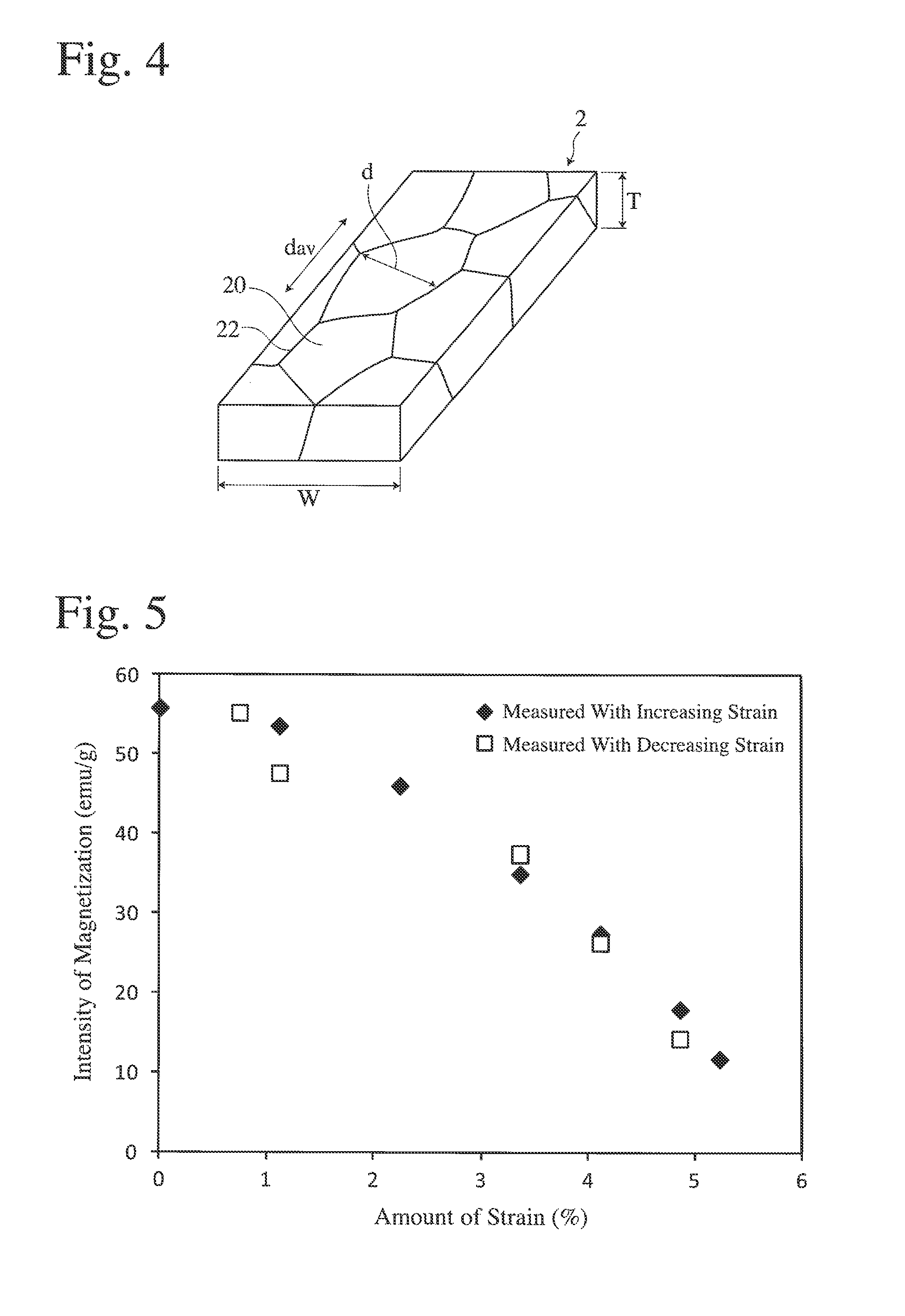Fe-based shape memory alloy and its production method
a technology of shape memory and alloy, applied in the field of fe can solve the problems of poor workability, limited application of ti—ni alloy, iron-based shape memory alloy still suffering various unsolved problems, etc., and achieve excellent hyperelasticity and shape memory effect, excellent workability
- Summary
- Abstract
- Description
- Claims
- Application Information
AI Technical Summary
Benefits of technology
Problems solved by technology
Method used
Image
Examples
example 1
Solution-Treated Samples
[0064]Each Fe alloy having the composition shown in Table 1 was high-frequency-melted, cast, hot-rolled, and then cold-rolled to a plate thickness of 0.25 mm. The cold-rolled alloy was cut to a width of about 1 mm, solution-treated at 1200° C. for 30 minutes, and then hardened with water.
[0065]Aged Samples
[0066]Each of the above solution-treated samples was further subject to an aging treatment at 200° C. for 1 hour.
[0067]
TABLE 1AlloyAlloy Composition (atomic %)No.MnAlNiFe10130145Balance10233145Balance10336155Balance10440165Balance1053214.56.5Balance10635156.5Balance10736156.5Balance1083915.56.5Balance1093014.57.5Balance11034157.5Balance11135157.5Balance11236157.5Balance11334158Balance1143415.58Balance11536158Balance11640178Balance1173214.59Balance1183314.59Balance11936159Balance12036169Balance121341510Balance1223515.510Balance123361510Balance1244016.510Balance1252613.55Balance 126*3615—Balance 127*40164Balance 128*401615Balance 129*45157.5Balance 130*40107.5...
example 2
[0075]Each Fe-based alloy was produced in the same manner as in Example 1, except for substituting part of Fe with the element (fifth component) shown in Table 3 in the composition of Alloy No. 110 produced in Example 1. The shape memory characteristics of these alloys by hyperelasticity were measured by the same method as in Example 1, and shown in Table 3.
[0076]
TABLE 3Amount ofSE(1) (%)AlloyFifth-ComponentSolution-TreatedNo.Element (atomic %)SampleAged Sample201Si:28195202Ti:17088203V:17991204Cr:36986205Co:26181206Mo:17493207W:17193208B:0.058797209C:0.28291Note:(1)SE represents a shape recovery ratio by hyperelasticity.
[0077]The Fe-based alloys having magnetic properties, corrosion resistance, strength, ductility, etc. improved by the addition of an element of Si, Ti, V, Cr, Co, Mo, W, B, C, etc. had excellent shape recovery ratios. Also, the aging treatment improved the hyperelasticity effect, resulting in as high a shape recovery ratio as 60% or more.
example 3
[0078]The magnetic properties of Fe-based alloys (Alloy Nos. 103, 107, 109, 110, 115, 119 and 123) produced in Example 1 were measured at room temperature by a vibrating sample magnetometer (VSM). Their intensities of magnetization at 1.5 T are shown in Table 4.
[0079]
TABLE 4Intensity of Magnetization (emu / g)AlloySolution-TreatedNo.SampleAged Sample1035657107515210971731105759115303111926291232225
[0080]The matrix is dominant at room temperature in Alloy Nos. 103, 107, 109 and 110, and the martensite phase is dominant at room temperature in Alloy Nos. 115, 119 and 123. Table 4 indicates that the matrix is ferromagnetic, and that the martensite-dominant samples have smaller magnetization than that of the matrix. After these samples were cold-rolled by 50% to be completely martensitic, all samples had magnetization of 1 emu / g or less, indicating that the martensite phase was paramagnetic or antiferromagnetic.
[0081]Further, each of the solution-treated samples and aged samples of Alloy N...
PUM
| Property | Measurement | Unit |
|---|---|---|
| temperature | aaaaa | aaaaa |
| temperature | aaaaa | aaaaa |
| diameter | aaaaa | aaaaa |
Abstract
Description
Claims
Application Information
 Login to View More
Login to View More - R&D
- Intellectual Property
- Life Sciences
- Materials
- Tech Scout
- Unparalleled Data Quality
- Higher Quality Content
- 60% Fewer Hallucinations
Browse by: Latest US Patents, China's latest patents, Technical Efficacy Thesaurus, Application Domain, Technology Topic, Popular Technical Reports.
© 2025 PatSnap. All rights reserved.Legal|Privacy policy|Modern Slavery Act Transparency Statement|Sitemap|About US| Contact US: help@patsnap.com



